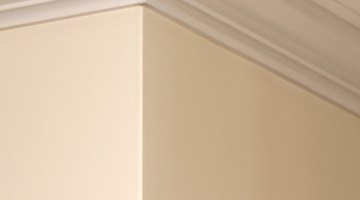How to Paint Coving
Coving is a type of trim that bridges the corner between the wall and ceiling. It is concave, meaning it curves inward. InvitingHome.com says the only real difference between coving and crown molding is that crown molding can curve outward toward the observer. Painting coving is like painting other surfaces and trim.

Things You Will Need
- Drop cloths or plastic tarps
- Ladder
- Painter’s tape
- Paintbrush
- Paint roller and tray (optional)
-
Move everything away from the walls with the coving you'll be painting. Remove the items from the room or cover with tarps or drop cloths.
-
Tape drop cloths or plastic tarps to the walls underneath the coving with painter’s tape to protect them from paint drips and spills. Because you’ll likely be on a ladder, have an assistant on standby to hold the ladder steady. Line up the edge of the tape with the edge of the coving so no wall is exposed.
-
Spread the tarps out on the floor so that paint from the top of the coving, which curves away from the wall and toward the center of the room, doesn’t drip paint onto the floor if you accidentally apply too much.
-
Tape off the edge of the ceiling next to the coving if you’re leaving it unpainted or have painted it a different color.
-
Paint the coving using a paintbrush. Move the brush horizontally along the coving, and make light strokes a few inches long, working within 2-foot sections. Popular Mechanics recommends working right to left if you are right-handed and vice versa if left-handed. Give the coving only one coat right now if you’re also painting the ceiling. If the coving has a lot of detail, you might need a smaller brush to get into all the crevices. Leave the paint to dry according to the manufacturer's instructions.
-
If you are painting the ceiling the same color as the coving, paint the first couple of inches of ceiling adjacent to the coving with the brush. HomePaintersInfo.com says this will make painting the rest of the ceiling with a roller much simpler.
-
Paint the ceiling with two coats, if you are painting it the same color as the coving. Use the roller and paint tray. Let the paint dry in between coats.
-
Give the coving its second coat of paint once the first has dried. Carefully remove the tape once the paint is no longer tacky and remove the plastic. Jeff Howell, author of “DIY for Dummies,” advises pulling the tape off at an angle so you don’t pull paint off the coving.
Warning
Ensure the room is ventilated. Always wear safety gear such as a mask, gloves and goggles, and wear old clothing that you don’t mind getting paint on.
If the coving and ceiling are both being painted but will be different colors, paint the ceiling first.
References
Warnings
- Ensure the room is ventilated. Always wear safety gear such as a mask, gloves and goggles, and wear old clothing that you don't mind getting paint on.
- If the coving and ceiling are both being painted but will be different colors, paint the ceiling first.
Writer Bio
Suzanne S. Wiley is an editor and writer in Southern California. She has been editing since 1989 and began writing in 2009. Wiley received her master's degree from the University of Texas and her work appears on various websites.
Photo Credits
- Jupiterimages/Photos.com/Getty Images
- Jupiterimages/Photos.com/Getty Images
More Articles



